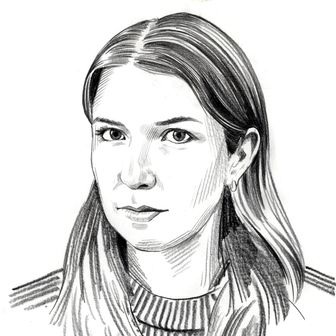
Death isnÔÇÖt always terminal in Alex PhebyÔÇÖs novel Malarkoi. Painful, yes. Gruesome, definitely. ItÔÇÖs just that, a lot of the time, it doesnÔÇÖt quite stick. A main character is killed by his double, who then becomes him. A girl suffocates to death in a tangle of people with cow heads, then wakes up again, ÔÇ£alive for no reason.ÔÇØ This book is the second in a trilogy called Cities of the Weft; in the first book, Mordew, a boy from the slums named Nathan Treeves is crushed down so small that he fits into a locket. In this one, he is dead, technically, but it doesnÔÇÖt mean much ÔÇö heÔÇÖs still able to call out to his dog. A meter is established: Someone dies. They return to life. Bones and flesh ooze back together.
This can be exhausting. ItÔÇÖs also exhilarating. Pheby is nothing if not generous with ideas: These resurrections happen in a world where nested pyramids stretch into the sky, where magic runs on the power of human sacrifice, and where the city of Mordew is built on the corpse of God. That is where the trilogy opens; the first book, published in 2020, follows Nathan, a destitute boy living on MordewÔÇÖs fringes. Nathan has something called a ÔÇ£Spark,ÔÇØ a magical ability that sets him apart from the other children in the slums. In Malarkoi, NathanÔÇÖs Spark has upended Mordew and his allies have escaped the slums ÔÇö and are now being tailed by a team of assassins.
While Pheby is writing fantasy, itÔÇÖs clear that his interests are political. A British professor of creative writing, he moved into genre fiction after publishing three other novels, all of which have to do with schizophrenia. These are books about the social dimension of madness, and they feel mad, too, with feverish descriptions of physical injury and terror. ÔÇ£If it was up to him,ÔÇØ one sadistic dentist thinks in 2018ÔÇÖs Lucia, a fictionalized telling of the life of James JoyceÔÇÖs schizophrenic daughter, ÔÇ£heÔÇÖd anesthetize the lot of them and do what needed to be done.ÔÇØ Cities of the Weft, which has been received enthusiastically by U.K. reviewers, shares that grim interest in cruelty. But the two books published from the trilogy so far introduce joy into the equation. ÔÇ£In fantasy fiction, you can really pile on the magic, I think, and everybody likes itÔÇöand I like writing it,ÔÇØ the author has said.
The seriesÔÇÖ visceral first book introduces the city of Mordew as a kind of nightmare version of DickensÔÇÖs London. Ragged groups of children roam the streets and beat dying firebirds with sticks. Eels are born with elbows and human teeth, and NathanÔÇÖs hovel is bare to the wind with lamps shining weakly through the gaps in its walls ÔÇ£as if light itself could be brought low by this place.ÔÇØ His father is dying slowly, painfully, afflicted by ÔÇ£lungwormsÔÇØ that he coughs up in several stunningly harrowing scenes. NathanÔÇÖs Spark gives him the ability to muster a violent surge of energy that he can direct at the world around him. Though his father has warned him against using it ÔÇö it has grisly effects on his body and soul ÔÇö Nathan summons his power to fish in the mud for small, squirming creatures to sell to the slumÔÇÖs tanneries and merchants. Meanwhile, high above the slums lives the Master, a mysterious figure in a mansion who makes children disappear.
Pheby clearly enjoys the fantasy genreÔÇÖs clich├®s, and he does funny things with them. Nathan is what you might call a chosen one. He falls in with a band of urchins: the Artful DodgerÔÇôesque Gam, feisty Prissy, and Joes, a strangely plural character who is both one person and two. (Pheby writes that ÔÇ£whether they were a boy or a girl Nathan couldnÔÇÖt tell, since they seemed to flicker from one to the other in the light of the fire.ÔÇØ) But once Nathan is crammed into a locket at the end of book one, he becomes inert ÔÇö and Pheby takes the loss of his protagonist as an opportunity to abandon his childÔÇÖs-eye view, starting Malarkoi with 150 pages of interlude before reentering the main action. This section goes deep underground. It trails a lungworm that bites a child. One chapter describes ÔÇ£many aeonsÔÇØ in the life of Joes and their descendants in the city of Malarkoi ÔÇö pronounced ÔÇ£malarkeyÔÇØ ÔÇö a pyramid-filled place near Mordew that was built by a seemingly benevolent goddess. The world we were introduced to in the previous book has changed shape: We learn that the Master has grabbed the tip of Mordew and pulled it up into the sky, ÔÇ£like a cook pulls off the gelatinous skin from a cooled gravy.ÔÇØ Everything in the slums is stretched into uncanny new forms. Bricks are spread thin, rats are now as long as snakes, and a glass road becomes impossibly steep.
Often, in this book, human characters seem beside the point. PhebyÔÇÖs real subject is objects. This recalls his 2015 novel Playthings, a fictionalized account of the life of schizophrenic German judge Daniel Paul Schreber, who came to believe that the people around him were machines or impostors and whose memoir was studied by Freud. In PhebyÔÇÖs telling, Schreber sees a group of schoolboys and says to himself: ÔÇ£They are temporary things made up from the dirt.ÔÇØ Other people on the street are puppets: ÔÇ£Marionettes. Demons. Mechanical birds.ÔÇØ In order to avoid being brutalized by the authorities around him ÔÇö his father, his doctor, the orderly at his asylum ÔÇö Schreber must learn to dominate what he sees as sinister figures made of cogs and wheels and bellows.
PhebyÔÇÖs trick in Mordew and Malarkoi is to extend this idea to a fantasy world and to let it play out as a drama of subjugation that sees dignity rather than menace in puppets, lockets, and worms. The most interesting moments in the series ÔÇö the ones that really push the limits of imagination, of taste, of sympathy ÔÇö have to do with things that are only sort of alive. A pair of mechanical mice wheel around the periphery of the MasterÔÇÖs mansion, cleaning up messes. A boy whoÔÇÖs confined to the form of a book can be closed by anyone who wants to shut him up. The Master was the one who built Mordew on the corpse of God, situating it on top of a thick mire that its residents call the Living Mud. It is filled with ÔÇ£dead-life,ÔÇØ elbowed eels included. Even the actual people in the story seem suspiciously like collections of objects: a criminal kingpin named Mr Padge is said to be shaped from ÔÇ£a block of butter gone rancidÔÇØ and topped off ÔÇ£with ringlets shaved from hair-sellers.ÔÇØ NathanÔÇÖs mother seems to be made of ÔÇ£oddments of ribbon and irregular pieces of silk.ÔÇØ
Stasis can seem the fate of any middle novel in a trilogy. The important introductions are out of the way, the final battle is yet to come, and theres a sense of killing time. Even as Malarkois characters travel down into caves and up pyramids, time can seem to stand still  and sometimes does literally stand still. The book begins with an index of unusual things that readers will learn about, like a near endless repetition of the same day. One of Malarkois most compelling plotlines has to do with the Master, who shuffles through dimensions where the hours pass at different speeds. These sections are mathy and dizzying, and you can sense Phebys pleasure in writing them, like this one describing a carefully calibrated wall of clocks, each of which represent a different realm: The next four clocks were realms subsidiary to this realm where the passage of time was faster, and each by a multiple of the last  the third row continued these multiples, and the fourth began the same sequence, but slower rather than faster. In one, you can live ten lifetimes without the minute hand making a single circuit.
This level of detail can make Malarkoi hard to keep up with. Pheby is smart enough to hint at the frustration of it all; at one point, when that book-boy is attempting to tell a story, one of the novelÔÇÖs talking dogs says, ÔÇ£This is another inferiority that invention has over the real ÔÇö it becomes necessary to interrupt the story to provide the information necessary to understand invented things.ÔÇØ (To which the boy flutters his pages in irritation.) Occasionally, story lines are smothered by explanations of Mordew and Malarkoi, their gods and their magic and their many rules and dimensions, and Malarkoi becomes more guidebook than narrative. Though PhebyÔÇÖs world is an unrestrained imaginative spectacle, it follows recognizable rules; here, too, sickness, poverty, and injustice dictate the trajectory of lives. And if this world contains, as MalarkoiÔÇÖs index reads, ÔÇ£a dog who eats a godÔÇÖs faceÔÇØ? As a goddess says to a puzzled child: ÔÇ£DonÔÇÖt think about it too much ÔÇö itÔÇÖs too confusing.ÔÇØ


